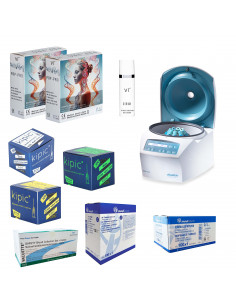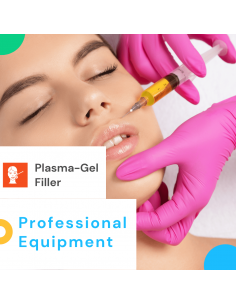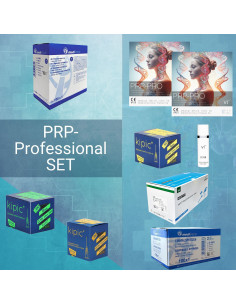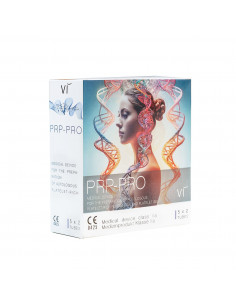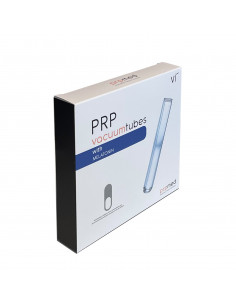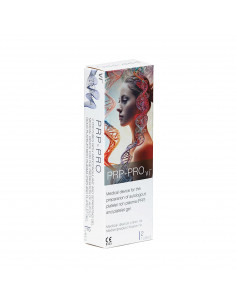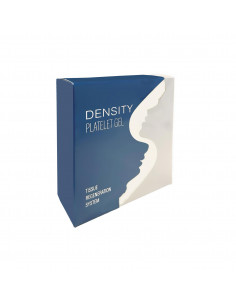PRP-Tubes

PRP Starter Set | EBA 200
Plasma Gel Filler - Professional Set
PRP Professional Set
PRP tubes | Vi PRP-PRO | with Anticoagulant PU 10 pieces
PRP tubes - with melatonin for hair treatment - PU 6 pcs.
PRP Tubes | Vi PRP-PRO (PU 2 pcs.)
PRP/CGF Tubes | without anticoagulants | PU 10 pcs.
What tubes to use for PRP?
Here you will find PRP tubes for the preparation of Platelet Rich Plasma.
PRP tubes for the production of Platelet Rich Plasma.
What is PRP therapy?
PRP is an injectable treatment that uses platelet rich plasma from the patient's own blood. The plasma component contains platelets that contain growth factors. When injected back into the skin, it accelerates the body's natural skin rejuvenation process.
Benefits and safety of Platelet Rich Plasma?
PRP has a number of benefits. The treatment can improve skin texture and tone, reduce fine lines and scars, and stimulate collagen and skin cell production for a plumper, more radiant complexion. PRP is actually a very safe injectable treatment because you are essentially using your own natural elements with no added foreign products.
What are PRP tubes and what are they used for?
PRP tubes are used by medical professionals to isolate platelets while eliminating unwanted components such as red blood cells and inflammatory white blood cells. PRP tubes allow the collection of highly purified autologous plasma with therapeutic properties. The PRP tubes contain a thixotropic gel that separates the supernatant plasma from the cellular components and makes it possible to obtain autologous plasma of a strong therapeutic effect.
The substances contained in the PRP tubes used for their manufacture enable the collection of autologous plasma suitable for injection into the body. The separating gel forms a reliable barrier during centrifugation, which prevents the plasma from mixing with erythrocyte extract.
Due to its regenerative properties, PRP has been used for more than ten years in many fields of medicine, including dentistry, maxillofacial surgery, cardiac surgery, orthopaedics, ophthalmology, urology, treatment of ulcers and wounds, etc.
Manufacturing process with PRP tubes
The production of PRP consists in the collection with PRP tubes of autologous venous blood (i.e. from the patient himself), which is then subjected to centrifugation with PRP centrifuge and concentrated.
The procedure for producing the PRP has been enormously simplified by adopting a protocol that requires the use of special PRP tubes and a special PRP centrifuge.
In fact, a small amount of venous blood (10-15 cc) taken by the doctor from the patient's arm is sufficient to obtain the ideal concentration, which is obtained by inserting the blood into the special tubes, which are centrifuged for a few minutes.
With this method, we obtain the plasma by separation, which contains highly concentrated platelets that produce the growth factors after activation. The compound can be injected under the skin with mesotherapy as well as with the classical direct infiltration into wrinkles or skin folds .
Unlike synthetic fillers, PRP is produced starting from components that come from the patient himself to ensure maximum biocompatibility and naturalness of the treatment and without the risk of intolerances, allergies or other immune reactions.
Applications of PRP tubes in medicine
Thanks to the high concentration of platelets, PRP (platelet-rich plasma) can induce biorepair processes through various growth factors released by the activation of platelets and through cytokines, molecular proteins that can stimulate cell growth and activity.
Through these regenerative processes, PRP helps and improves the healing of many imperfections such as scars, alopecia, skin ageing, acne, skin ulcers, etc. PRP also stimulates neo-angiogenesis, i.e. the development of new blood vessels starting from existing ones. PRP is able to improve proliferation and migration of fibroblasts, collagen synthesis and removal of necrotic cells.
PRP is widely used in dermatology, trichology, surgical oncology, gynaecology, orthopaedics and aesthetic and regenerative medicine.
In aesthetic and regenerative medicine, PRP (platelet-rich plasma) tubes are used to rejuvenate cheeks, eyelids, lips, nasolabial folds, forehead, skin folds in the neck, back of the hands and décolleté. PRP is an autologous treatment. The blood from which the platelets are extracted is taken from the patient himself. There are no immune reactions.
Talk to your doctor about the positive aspects of PRP therapy and find out about the various medical and cosmetic problems that can help you with the treatment. For example, try PRP to stop hair loss or get PRP injections for facial blemishes. Ask your doctors about the effectiveness of PRP treatment for knee pain or PRP therapy to get rid of acne scars and blemishes.
PRP therapy has been used for more than 15 years. The purpose of centrifugation is to separate the red blood cells and prevent them from clotting.
Centrifugation is usually performed at a rate high enough for 7-12 minutes to allow the red blood cells to settle. The additive should be an anticoagulant to prevent blood clotting. Sodium citrate or heparin sodium can be used as additives.
Each has its own nuances. Sodium citrate blocks calcium in the blood and prevents blood clotting. Heparin is involved in the formation of the thrombin-antithrombin III complex. Once bound, thrombin cannot convert fibrinogen to fibrin, so the blood does not clot. After heparin administration, clotting is almost impossible. Neither can prevent platelet aggregation.
It is worth noting that patients often develop hematomas after PRP injection supplemented with heparin.
The utility of Platelet Plasma (PRP) extends to various areas of dermatology, from the treatment of chronic ulcers to trichology and aesthetics, because of its role in wound healing. There is also great variation in the protocols for the standardization and manufacture of PRP. The cost of commercially available PRP Tubes precludes their use in a larger population.
BACKGROUND
Platelets are cytoplasmic fragments of megakaryocytes that are formed in the bone marrow, are approximately 2 µm in diameter and contain more than 30 bioactive proteins, many of which play a fundamental role in hemostasis or tissue healing; Seven basic protein growth factors that are actively secreted by platelets initiate the entire wound healing process. PRP also contains three proteins in the blood that are known to act as cell adhesion molecules: fibrin, fibronectin, and vitronectin.
Activation causes the granules present in the platelets to fuse with their cell membrane (also called degranulation), where secretory proteins (e.g. they are then secreted and bind to transmembrane receptors on target cells, which include mesenchymal stem cells, osteoblasts, fibroblasts, endothelial cells and epidermal cells. These agonists bind to transmembrane receptors and then activate an intracellular signaling protein that causes the expression of a genetic sequence that controls proliferation, matrix formation, osteoid production, collagen synthesis, etc., thus causing repair and regeneration to begin within 10 minutes of platelet cells Activation, with more than 95% of the pre-synthesized growth factors being secreted within 1 hour. Marx suggested that the platelet count of 10 lakh / ml in 5 ml PRP as a working definition of PRP based on scientific evidence of improved bone and white partial healing.
There are few studies that indicate the concentration at which optimal stimulation occurs. Rughettiet al.studied the relationship between the concentration of platelets in the platelet gel and changes in the functional activity of human endothelial cells; Endothelial cell proliferation and migration and invasion of endothelial cells occurred in a bell shape. of endothelial cells reaches a maximum of 1.25 × 10 6 and angiogenesis at 1.5 × 10 6 platelets / ml. This means that a PRP platelet count of 1 million / ml has become the working definition for therapeutic PRP and also justifies the criticism that PRP does not achieve the best expected results, which could be due to lower platelet concentrations.
According to the von Ehrenfest et al. (2009), four main families of preparations can be defined depending on the cell content and fibrin architecture.
1. Pure platelet-rich plasma (PPRP) or leukocyte-poor PRP products are preparations without leukocytes and with a low density fibrin network after activation.
2. White blood cell and PRP (LPRP) products are preparations containing white blood cells and a low density fibrin network after activation. In this family there are the greatest number of commercial or experimental systems, in particular, many protocols have been developed in an automated manner recently, requiring the use of special kits that allow minimum handling of blood samples and maximum standardization of preparations.
3. Pure platelet fibrin (PPRF) preparations or leukocytes poor in platelet fibrin are without leucocytes and with a high density fibrin network. These products only exist in highly activated gel form and cannot be injected or used like traditional fibrin glue.
4. Second generation leukocyte-platelet fibrin (LPRF) or PRP products are preparations with leukocytes and a high-density fibrin network.
PRP is used as an autologous product to enhance tissue repair in various diseases and injuries, especially musculoskeletal tissues such as cartilage injuries, tendinopathies, muscle strains and bone repair.
In addition to its clinical application, PRP can also be an effective fetal surrogate. The therapeutic potential of PRP is mainly due to the growth factors contained in platelet alpha granules, which have been shown to play an important role in tissue repair.
When platelets are concentrated and activated, the concentration of released factors is expected to reach three to five times that found in plasma. Whole blood with anticoagulants, followed by one or two centrifugation steps with special PRP tubes.
Platelet-depleted plasma is discarded and the remaining platelet pellet is homogenized into PRP. and the use and type of platelet activator and anticoagulant. If no anticoagulant is used, a blood clot will form and serum can be obtained without increasing the platelet concentration.
For transfusions, blood is usually collected in bags containing a phosphate dextrose adenine citrate solution (CPDA1) as an anticoagulant, from which a platelet concentrate is obtained by centrifugation of whole blood or apheresis; the platelet concentrates thus obtained can also be used. In contrast, newer PRP formulations for autologous applications are usually prepared in collection tubes containing citrate solutions in the form of sodium citrate or ACDA; the latter, ACD, is included in most commercially available tubes for PRP preparation.
In other cases, heparin or EDTA may be used. In clinical investigations, EDTA is commonly used for hematologic testing, CS for coagulation testing, and ACD for measuring plasma levels of platelet-derived components. The choice of anticoagulant for blood collection would affect the properties of PRP as well as its effects on the culture of mesenchymal stromal cells.


